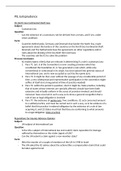Operations and Supply Chain Management,
2024 Release by William J Stevenson
Complete Chapter Solutions Manual
are included (Ch 1 to 19)
** Immediate Download
** Swift Response
** All Chapters included
,Chapter 01 - Introduction to Operations Management
CHAPTER 01
INTRODUCTION TO OPERATIONS MANAGEMENT
Teaching Notes
Many students come to this course with negative feelings, perhaps because they have heard that the
course includes a certain amount of quantitative material (which many feel uncomfortable with), or
perhaps because the course strikes them as “how to run a factory.” Others seem to have very little idea
about what operations management is. I view the initial meeting with my classes, and this first chapter, as
opportunities to dispel some of these notions, and to generate enthusiasm for the course.
Highlights of the chapter include the following:
1. Operations as one of the three main functional concerns of most organizations.
2. The role and job of the operations manager as a planner and decision-maker.
3. Different ways of classifying (and understanding) production systems.
4. System design versus system operation.
5. Major characteristics of production systems.
6. Contemporary issues in operations management.
7. Operations as essentially managerial (planning, staffing, etc.)
8. The historical evolution of production/operations management.
9. Manufacturing operations versus service operations.
10. The need to manage the supply chain.
Reading: Why Manufacturing Matters
1. Given that the U.S. economy is becoming more service based, the percentage of employment in
manufacturing is declining while the percentage of employment in the service industry is
increasing. In addition, the loss of manufacturing jobs results in the loss of service jobs as well (a
general estimate is that four service jobs are lost for each manufacturing job lost).
2. The government could offer companies tax incentives for purchasing new equipment or for hiring
workers. In addition, the government could work with manufacturing companies to re-train
workers in more advanced manufacturing processes.
3. Manufacturing innovation is important because it requires high value-added knowledge work that
supports future innovation. Second, innovation generates high-paying jobs. Third, innovation is
important because it improves productivity, thereby slowing the outsourcing of jobs to lower
wage countries.
Reading: Agility Creates a Competitive Edge
The first solution could be for U.S. retailers to continue sourcing from China that part of demand that is
certain and to source uncertain demand from the same low-cost producers in Romania and Turkey.
1-1
,Chapter 01 - Introduction to Operations Management
This approach provides the advantages of low-cost manufacturing in China and the flexibility provided by
the suppliers in Romania and Turkey. The disadvantage of this approach is that transportation times for
U.S. retailers still will be longer than the transportation times faced by Zara’s and H & M.
A second approach could be that U.S retailers find low-cost, flexible suppliers just across the border in
Mexico. The advantages of this approach include low wages and shorter transportation times. The
primary disadvantages to this approach involve the time and expense of locating new suppliers.
Additionally, the U.S. retailers might have to lend considerable support developing the capabilities of
these suppliers.
Reading: Sustainable Kisses
1. Hershey’s and other companies engage in sustainable business practices because consumers
prefer to do business with companies that practice sustainable sourcing and ethical treatment of
workers. Many of the leaders in these businesses hold the same values. By educating farmers,
Hershey’s can also help to increase the longevity and yield of cocoa plants.
2. Hershey’s actions may influence retailers and customers in its supply chain to become better-
educated about sourcing, which may influence competitors to adopt similarly sustainable business
practices.
Operations Tour: Wegmans Food Markets
1. Customers judge the quality of a supermarket based on:
a. Quality of individual products.
b. Exterior and interior physical look of the store.
c. Effectiveness and efficiency of service personnel.
2. a. Customer satisfaction is the major key to the success of any operation; without it, the
company cannot survive.
b. Forecasting allows the company to plan the workforce levels, purchase quantities, inventory
levels, and capacity.
c. Capacity planning allows the company to balance the trade-off between shortages and excess
inventories and between waiting lines and idle time.
d. A good location can have a significant impact in attracting customers, thus improving sales.
e. Planning and controlling levels of inventory will assist with avoiding stockouts and avoiding
excess inventory levels.
f. Good layout of the store can assist in maximizing customer service and sales by strategically
directing customers through the store. An effective layout can also improve the efficiency of
the operations.
g. Effective scheduling of company workers and work hours can improve both customer service
and efficiency. An effective schedule provides convenient store hours, minimal customer
waiting lines, and minimal employee idle time.
3. Wegmans uses technology to track inventory and manage its supply chain, which lessen the risk
of occurrences of out-of-stock events, and to maintain freshness in its meat and produce
departments.
1-2
, Chapter 01 - Introduction to Operations Management
Answers to Discussion and Review Questions
1. The term operations management relates to the management of systems or processes that create
goods and/or provide services. These processes involve the planning, coordination, and execution
of all activities within an organization that create goods and services. A supply chain is the
sequence of organizations, including their facilities, functions, and activities, that are involved in
producing and delivering a product or service. This sequence begins with basic suppliers of raw
materials and ends with the final customer. A supply chain includes activities and facilities
external to the internal operations function, e.g., sourcing and transportation of inbound materials.
2. The three primary functions are operations, finance, and marketing. Operations is concerned with
the creation of goods and services, finance is concerned with provision of funds necessary for
operation, and marketing is concerned with promoting and/or selling goods or services.
3. The operations function consists of all activities that are related directly to producing goods or
providing services. It is the core of most business organizations because it is responsible for the
creation of an organization’s goods or services. Its essence is to add value during the
transformation process (the difference between the cost of inputs and value and price of outputs).
4. Among the important differences between manufacturing and service operations are:
a. The nature and consumption of output.
b. Uniformity of input.
c. Labor content of jobs.
d. Uniformity of output.
e. Measurement of productivity.
Among the important similarities between manufacturing and service operations are:
a. Forecasting and capacity planning to match supply and demand.
b. Process Management
c. Managing variations
d. Monitoring and controlling costs and productivity
e. Managing the supply chain
f. Location planning, inventory management, quality control and scheduling
5. a. The Industrial Revolution began in the 1770s in England, and spread to the rest of Europe and
to the U.S. in the late eighteenth century and the early nineteenth century. A number of
inventions such as the steam engine, the spinning Jenny, and the power loom helped to bring
about this change. There were also ample supplies of coal and iron ore to provide the
necessary materials for generating the power to operate and build the machines that were
much stronger and more durable than the simple wooden ones they replaced.
1-3






